How to prepare and write a stellar ESG report in 2024
You may have started hearing “ESG” pop up in conversation, especially around the end of the year. If you’ve dismissed it as just another acronym to look up later, you might be falling behind.
ESG and ESG reporting are becoming increasingly important, and some organizations will have to file their first ESG reports in 2024 and 2025.
Here’s your guide to ESG reports—and how to prepare your own, including:
- What is an ESG report?
- What should an ESG report include?
- Environmental criteria
- Social criteria
- Governance criteria
- ESG reporting standards
- ESG reporting frameworks
- ESG scoring, research, and ratings
- How ESG reporting varies by region
- The best ESG report examples
- FAQs about making an ESG report
- Conclusion: Create an ESG report with Prophix
What is an ESG report?
ESG (environment, social, and governance) reports are used by organizations to communicate the steps they’re taking to make positive changes in the environmental, social, and governance impact of their operations. While many organizations have long tried to show how they work to lessen their impact on the environment, advance civil rights, equality, and create governance policies that are fairer for all, a lack of benchmarks has made this difficult.
With ESG reporting—and the associated frameworks—organizations now have a common language for communicating this.
Who requires ESG reports?
This depends entirely on the jurisdiction your organization operates in. In some jurisdictions, organizations are legally required to submit ESG reports. These are developing requirements, with many companies needing to make their first ESG reports in 2024 or 2025.
The EU, for example, passed the Corporate Sustainability Reporting Directive (CSRD) in early 2023, which makes ESG reporting mandatory for most organizations operating in Europe. Only companies with less than 10 employees or revenues below EUR 20 million are excluded.
While not all jurisdictions enforce mandatory ESG reporting, the practice is becoming widespread worldwide. For instance, 99% of S&P 500 companies are reporting on ESG.
What should an ESG report include?
An ESG report needs to cover the environmental, social, and governance impacts of the organization’s operations. To that end, make sure your reports include the actions taken to address the following:
- Environmental: Climate change, carbon emissions, biodiversity, as well as resource usage and procurement.
- Social: Promoting diversity, equity, inclusion, data protection and privacy, employee engagement, human rights, and labor standards.
- Governance: Internal controls, executive compensation, shareholder rights, lobbying, political involvement, whistleblower programs.
How to report non-financial information
Many organizations have reporting on financial information down to a science but may not have processes in place for ESG reporting—especially with many standards being so new. But with a host of frameworks and guidelines already available, you don’t have to start from scratch. Here’s a step-by-step process for reporting on your ESG activities.
- Audit your organization for ESG objectives, processes, and achievements.
- Identify the ESG standards your organization needs to abide by.
- Pick an established ESG framework to base your report on.
- Gather the necessary data from stakeholders.
- Prepare reports, visualizations, and communication plans.
- Get external input on your ESG report—and whether you’ve met the necessary requirements.
How to write an ESG report
ESG reports come in multiple formats, depending on who they’re being written for. If a regulatory body in your jurisdiction makes them mandatory, you’ll need to refer to their preferred framework before drafting your ESG report. From that framework, you can either create a template following the appropriate guidelines or use a pre-existing one. This template from Invest Europe, for example, shows what an ESG report would look like for a European company.
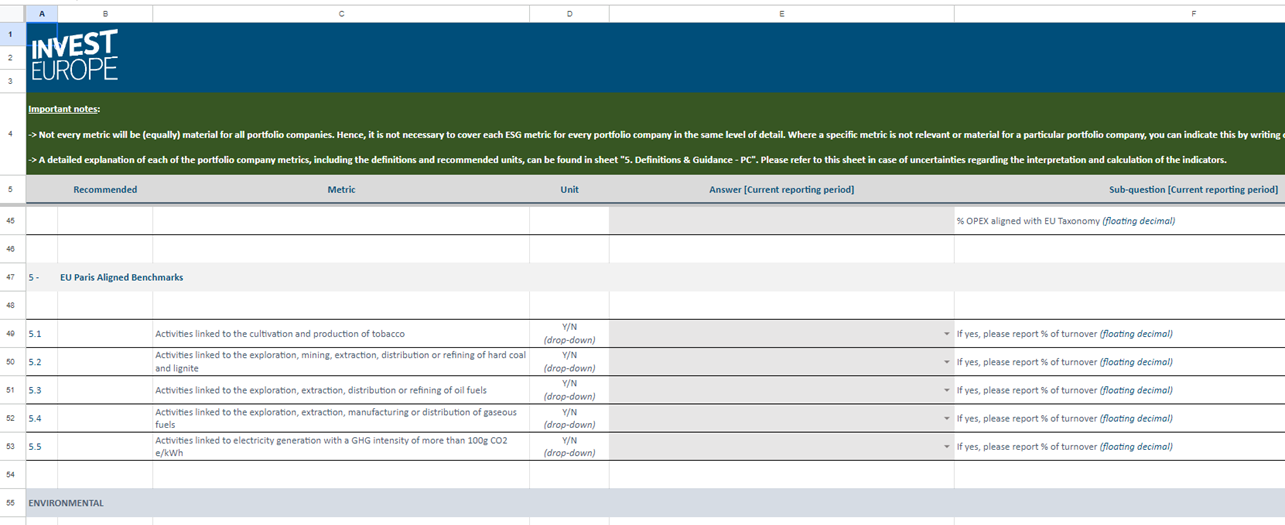
You should ensure that it lists all necessary ESG metrics as clearly as possible.
In jurisdictions where ESG reports aren’t mandatory, you have much more flexibility in how they’re created. You could include the following:
- ESG “balance sheet”: Much like when public companies file quarterly earnings, you should have a balance sheet of sorts detailing all the ESG metrics you’re tracking and reporting on, especially if you can compare them against performance from previous years.
- Write-ups from leaders: While not all ESG reports need this, having a few paragraphs from your organization’s CEO and other influential leaders can help communicate your vision to investors.
- Impactful slides: Much like you would for a presentation, pull out data that’s particularly reflective of the strides you’ve made or the challenges you’ve had to face.
Here are some examples of what you’d find in an ESG report, taken from Nike’s FY22 Impact Report, which tracks the company’s performance across ESG metrics.
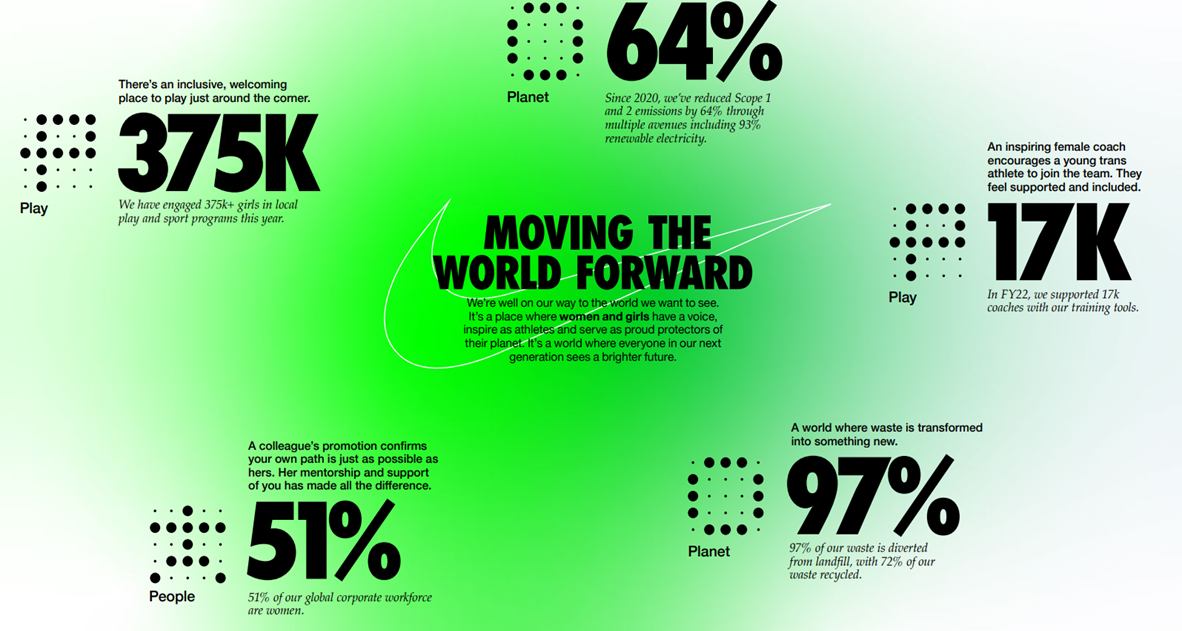
Just because you’re reporting on serious metrics doesn’t mean you can’t have impactful graphics the way you’d have in an external presentation. Remember that ESG reports are often used by investors to make better decisions, so you want to strike a balance between impact and thorough reporting.
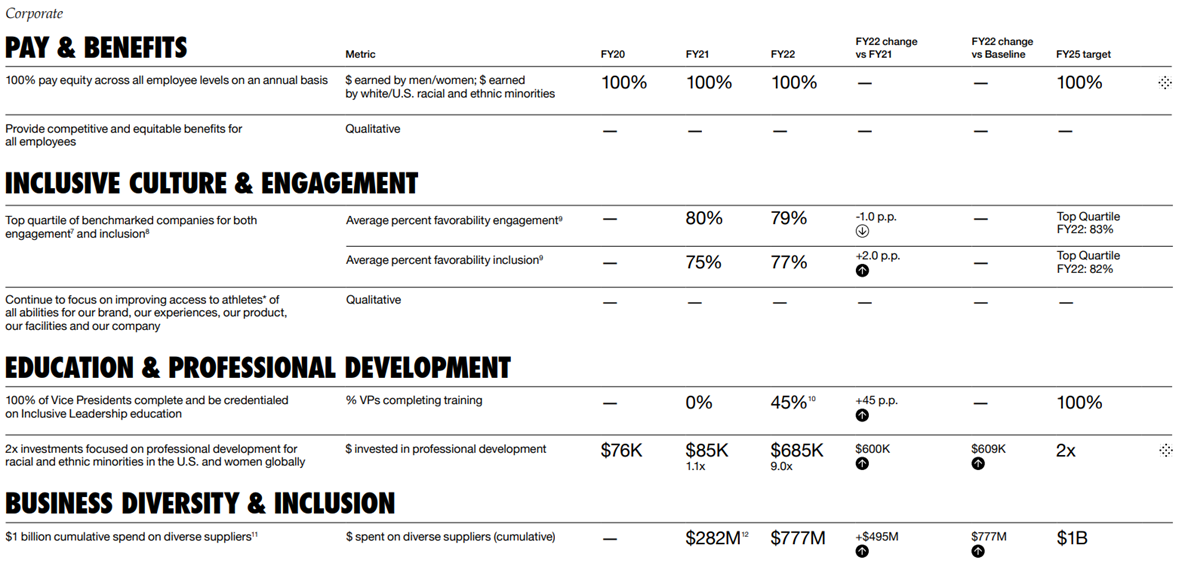
When crafting ESG resorts, you’ll want to go into detail about how your actions have allowed you to meet ESG targets, and how your efforts have compared to previous years.
Environmental criteria
The environmental criteria in ESG reports allow organizations to communicate the impact their operations have on the environment and the actions they’re taking to reduce these impacts. Here are the criteria involved:
- Climate change
- Carbon emissions
- Product carbon footprint
- Financing environmental impact
- Climate change vulnerability
- Natural resources
- Water stress
- Biodiversity and land use
- Raw material sourcing
- Pollution and waste
- Toxic emissions and waste
- Packaging material and waste
- Electronic waste
- Environmental opportunity
- Opportunities in clean tech
- Opportunities in green building
- Opportunities in renewable energy
Climate change
How is your company combating climate change? Keeping climate change top-of-mind is becoming increasingly important to consumers and investors alike.
This section of the report should include data regarding carbon emissions, product carbon footprint, climate change vulnerability, and financing environmental impact.
Natural resources
Reporting on your company’s natural resource usage is also crucial. Your ESG report should be detailed about raw material sourcing, biodiversity and land use, and water stress.
Pollution & Waste
Greenhouse gas emissions is the most important data point in this section, but your report should also include more specific pollution data.
It’s also important to include information on toxic emissions and electronic waste, as well as information on company packaging material. Including how and where your company sources water is also key.
This section around waste and pollution will be highly scrutinized by those who value environmental ethics, so the data should be clear and thorough.
Environmental opportunities
Opportunities are important to report on in any organization, but especially so if there’s significant room for improvement in your organization. No company is 100% environmentally conscious, so having identified clear plans to improve is going to look favorable on your report.
Including areas of improvement around clean tech, green building, and renewable energy will make for a strong opportunities section.
Social criteria
The social pillar in ESG covers how an organization manages relationships with its shareholders, employees, suppliers, and more. Here’s everything that falls within its scope:
- Human capital
- Labor management
- Health and safety
- Human capital development
- Supply chain labor standards
- Product liability
- Product safety and quality
- Chemical safety
- Financial product safety
- Privacy and data security
- Responsible investment
- Health risks
- Stakeholder opposition
- Controversial sourcing
- Social opportunity
- Access to communication
- Access to finance
- Access to health care
- Opportunities in nutrition and health
Human capital
When reporting on human capital, consider including data around labor management, health and safety, human capital development, and supply chain labor standards.
How easily, safely, and happily the employees and collaborators can work will be a crucial section of your ESG report. When consumers and investors think about “ethical companies” the treatment of employees will likely come to mind first, so ensuring clarity with your data here is key.
Product liability
Another way an organization affects people, both employees and consumers, is with their product. In general, reporting on responsible investment and financial product safety is a must.
For physical products, you’ll want to include information on product safety and quality, chemical safety, and other applicable health risks and considerations.
For digital products and services, include privacy and data security information.
Stakeholder opposition
The main thing to touch on under stakeholder opposition is controversial sourcing. Obtaining materials and goods associated with environmental, social, or ethical concerns is considered controversial sourcing.
Social opportunities
Much like the environmental section of your ESG report, you should also indicate social opportunities and areas of improvement.
An increasingly crucial part of the report centers around diversity, equity, and inclusion (DEI). What is your company’s DEI plan, and what strides have they made in the organization?
Other areas of opportunity should include social accessibility, like access to communication, finance, healthcare, and resources on nutrition and health.
Governance criteria
The corporate governance pillar of ESG refers to the policies and rules put in place to manage how an organization is controlled and directed. Here are the criteria that fall within this pillar:
- Corporate governance
- Board diversity
- Executive compensation
- Ownership
- Accounting
- Corporate behavior
- Business ethics
- Anti-competitive practices
- Corruption and instability
- Financial system instability
- Tax transparency
Corporate governance
Starting right at the top of the organization, your ESG report should include data on board diversity, ownership, and accounting.
Pay transparency is also becoming an ethical standard, so include data on executive compensation as well.
Corporate behavior
This is where your organization’s business ethics will be looked at closely. Anti-competitive practices, corruption and instability, financial system instability, and tax transparency are key points to report on.
Cybersecurity
Which security protocols and certifications does your organization meet? Applicable compliance points and areas of improvement are important to note here.
ESG reporting frameworks
What is an ESG framework?
An ESG framework provides organizations with the guidelines they need to properly report on environment, social, and governance criteria. It serves as a set of benchmarks, a common tool for accurate communication with stakeholders, and a reference for best practices.
Depending on the jurisdiction it falls under, your organization may be subject to multiple ESG frameworks.
Climate Disclosures Standards Board (CDSB)
First established in 2007, the CDSB provided one of the first frameworks for reporting on climate information. It has since been consolidated into the IFRS foundation, centralizing its framework with other international accounting standards.
International Integrated Reporting Council (IIRC)
The IIRC is another example of an early ESG reporting framework that was consolidated with the IFRS to centralize these standards. However, it’s still a powerful framework for organizations making ESG disclosures—especially if you’re in a jurisdiction that hasn’t yet established its own framework.
Task Force on Climate-Related Financial Disclosures (TCFD)
The TCFD was created by the Financial Stability Board (FSB) in 2015 to facilitate the reporting of climate-related financial data. It’s since been disbanded, with the framework being integrated into the IFRS foundation as it became part of global ESG standards.
What is an ESG standard?
ESG standards go one step beyond ESG frameworks. Instead of just being guidelines for your organization to follow, they’re the metrics and requirements you need to abide by when creating compliant ESG reports. If a framework is a blueprint for what you’re building, the standard is the building code.
EFRAG Sustainability Reporting Board
Relevant for European organizations needing to make ESG disclosures, the EFRAG Sustainability Reporting Board makes recommendations to European institutions and authorities to establish sustainability reporting standards.
Global reporting initiative (GRI)
In operation for more than 25 years, GRI creates and shares standards for reporting on biodiversity, tax, waste management, emissions, diversity, equality, and more.
International Sustainability Standards Board (ISSB)
Formed by the IFRS in November of 2021, the ISSB is one of the leaders in providing ESG reporting standards, having absorbed frameworks from other organizations to create a universal standard. The board is still working on these standards, making important strides in emissions reporting, global accessibility, and more.
ESG scoring, research, and ratings
Carbon Disclosure Project (CDP)
The CDP aims to measure the environmental impacts of investors, companies, cities, and governments. They’re a not-for-profit charity and run the global disclosure system, building a more sustainable economy for all.
Institutional Shareholder Services (ISS)
The ISS provides objective shareholder meeting research and recommendations. They are global leaders in corporate governance and provide end-to-end workflow solutions and multiple voting policy choices for institutional investors.
Just Capital
Just Capital ranks America’s most just companies by multiple criteria. They are the leading platform for reporting on, measuring, and improving corporate performance in the stakeholder economy.
Morningstar Sustainalytics
Sustainalytics, also known as Morningstar Sustainalytics, takes an organization's ESG data and provides an overall rating for investors to evaluate funds. The rating is a scale of 1-5 globes, with a one-globe rating being the weakest, and a five-globe rating the strongest.
MSCI
The Morgan Stanley Capital International rating assesses a company’s management of financially relevant ESG opportunities and risks. The MSCI looks at the long-term commitment to positive ESG scores and assigns a letter grade based on impact.
S&P Global Corporate Sustainability Assessment (CSA)
The CSA is a yearly assessment of an organization’s sustainability practices. Founded in 1999, the CSA focuses on industry-specific criteria and awards a score from 0-100, with a score of 70 or more considered “good”.
S&P TruCost
Climate change risks, natural resource usage, and broader ESG risks are assessed with S&P TruCost ratings. They are a global leader in carbon and environmental data and risk analysis.
Vigeo Eiris
Vigeo Eiris provides ESG services and research for organizations and investors, both public and private. They evaluate company strategies and operations around sustainability and how ingrained they are as consistent practices.
Internal ratings
To stay on top of ESG preparedness, companies often implement internal ESG scorecards that are routinely revisited. These scorecards evaluate the performance of the company based on the many intricacies of ESG criteria, to ensure a consistent organization-wide improvement.
How ESG reporting varies by region
Not sure if ESG reporting is mandatory in your jurisdiction? Need to know which framework you can refer to? Let’s do a quick roundup of some of the biggest jurisdictions and their ESG requirements.
USA
Mandatory or optional: Not currently mandatory, but 96% of S&P 500 companies published an ESG report in 2022.
Governing body: The U.S. Securities and Exchange Commission (SEC).
Preferred frameworks: While there are no regulatory frameworks in the USA, some benchmark frameworks include the Carbon Disclosure Project (CDP) and the Global Real Estate Sustainability Benchmark (GRESB).
Canada
Mandatory or optional: While not currently mandatory for most organizations, by May 2024, some government agencies and private companies will have to report some elements that fall within ESG reporting, such as the use of forced or child labor. By the end of 2024, ESG reporting will be mandatory for more organizations, like large banks and insurance companies.
Governing body: The Canadian Sustainability Standards Board (CSSB)
Preferred frameworks: While there are no frameworks specific to Canada, the Global Reporting Initiative (GRI), Sustainability Accounting Standards (SASB), and the Task Force of Climate-related Financial Disclosures (TCFD) can be followed by Canadian companies.
UK
Mandatory or optional: Currently mandatory for larger public companies, companies with more than 500 employees, or companies with more than £500 million in annual revenue. Currently only covers energy usage and carbon emissions.
Governing body: The Financial Conduct Authority (FCA)
Preferred framework: Streamlined Energy and Carbon Reporting (SECR)
EU
Mandatory or optional: Already mandatory for many European entities. Projected to be mandatory for all European organizations by 2027-2028.
Governing body: Organizations can seek ESG ratings from individual providers, but all providers need authorization from the European Securities and Markets Authority (ESMA) before giving out ratings.
Preferred framework: The Corporate Sustainability Reporting Directive (CSRD)
Asia
Mandatory or optional: Requirements vary by region. For example in Singapore, ESG reporting has become mandatory for many organizations, while Japan doesn’t have any specific laws or requirements for ESG reporting, but does have regulations covering individual elements that fall within ESG.
Governing body: Governing bodies vary based on the Asian region organizations operate in.
Preferred frameworks: There is no single preferred framework for all of Asia.
The best ESG report examples
If you’re getting ready to draft your own ESG reports but need some inspiration, look no further than some of the largest organizations in the world.
Microsoft

Despite not being required to do so by their jurisdiction, Microsoft shares its performance on certain key ESG metrics through multiple publications, like its Environmental Sustainability Report. Metrics they share in these publications include:
- Carbon emission reduction
- Water preservation
- Waste reduction
- Ecosystem protection
Microsoft uses multiple frameworks for its ESG reports, including the Sustainable Accounting Standards Board (SASB), the UN’s Sustainable Development Goals (SDGs), and the Global Reporting Initiative (GRI).
IBM
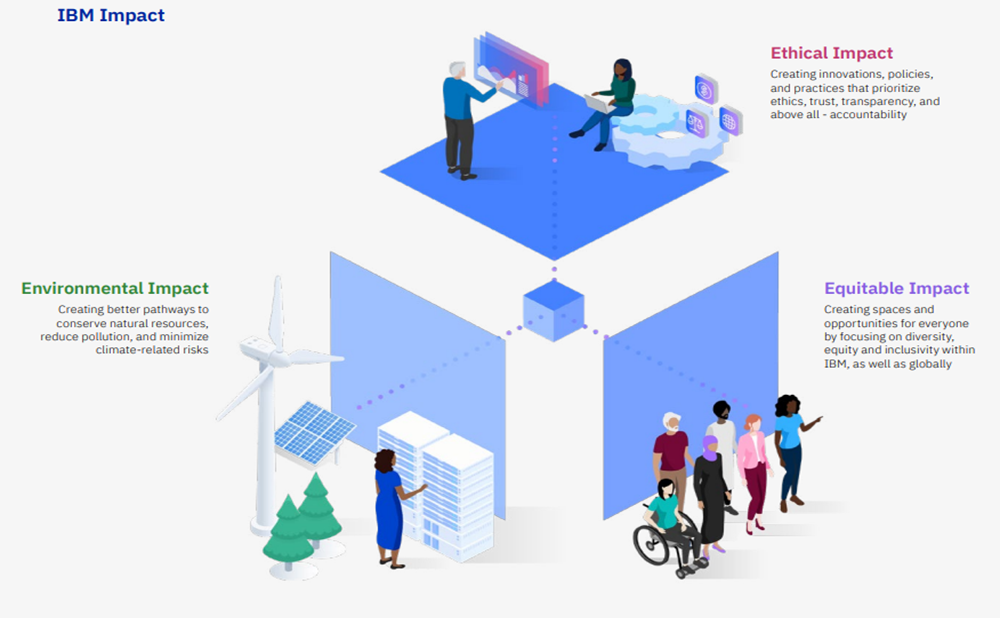
IBM’s Impact Report covers the company’s actions toward improving its ethical, equitable, and environmental impact. Here are some of the ESG metrics that are tracked through this report:
- Business ethics
- Policy advocacy
- Community development
- Diversity and inclusion
- Conservation and biodiversity
- Pollution prevention and waste management
Frameworks used in this ESG report include Corporate Social Responsibility (CSR) and GRI. Some publications covering areas like diversity, equity, and inclusion use IBM’s own framework.
Netflix
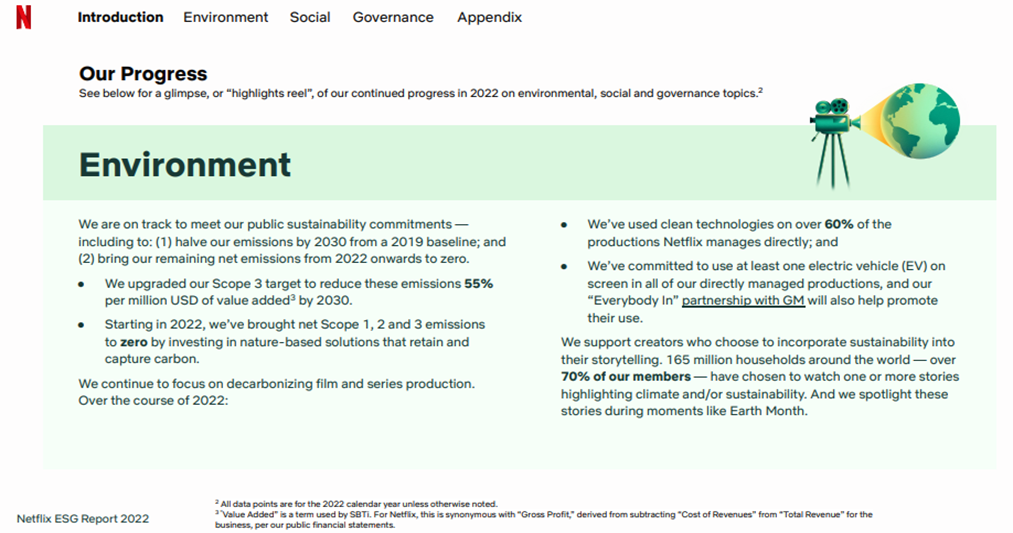
Netflix has been publishing an Environmental Social Governance Report since 2019, meaning it’s ahead of the curve compared to many organizations of its size. Here are some of the metrics it tracks in its report:
- Sustainability strategy
- Climate risk
- Inclusion and diversity
- Responsible products
- Corporate governance
- Ethics and compliance
Frameworks used by Netflix for its ESG reports include those laid out by the SASB, GRI, and TCFD.
Apple

Apple doesn’t just produce a yearly ESG Report, but it also uses the GRI, SASB, and TCFD frameworks to create and share its own ESG Index. Among other metrics, Apple uses this report to track its impact on:
- Climate change
- Resource management
- Growth and development
- Compensation
- Affordable housing
- Corporate governance
The frameworks listed above allow Apple to provide a more comprehensive view of its investments in ESG initiatives.
FAQs about making an ESG report
What is an ESG report?
An ESG report is an analysis of the environmental, social, and governance (economic) practices within an organization. The data points presented within the different categories of the ESG report influence a company’s broader optics for consumers, stakeholders, and investors.
What are the ESG reporting requirements?
Specific ESG reporting requirements will vary depending on the jurisdiction where the report is being conducted, but they may include metrics such as employee turnover rate, diversity in leadership, waste output, and more.
Is ESG reporting mandatory in Europe?
ESG reporting is mandatory in some jurisdictions within Europe and is projected to be mandatory for the broader continent by 2027-2028.
What are the 3 pillars of ESG?
The 3 pillars of ESG reporting are:
- Environmental criteria
- Social criteria
- Governance criteria
What is an example of ESG reporting?
Netflix has been providing ESG reports since 2019. An ESG report from Netflix includes metrics on climate risk, sustainability strategy, responsible products, diversity and inclusion, and ethics and compliance.
Why do companies do ESG reporting?
Aside from it being mandatory in some jurisdictions, companies may choose to complete an ESG report to establish themselves as an ethical brand. Positive brand awareness from an ESG report may impact a company’s growth and long-term success.
What is the difference between ESG and sustainability?
Sustainability is a broader term for the protection of people and the planet, whereas ESG focuses on material issues that pose a financial risk to a company due to its practices, industry, and business operations.
Why is ESG reporting needed?
ESG is needed to establish a global, ethical standard from an environmental, social, and governance perspective. ESG reports are a way to hold organizations accountable and encourage them to strive towards improving these areas based on jurisdiction-specific metrics.
Conclusion: Create an ESG report with Prophix
ESG reporting is still in its infancy, and international standards are just starting to become clear. While not all jurisdictions have made this kind of reporting mandatory yet, many organizations have either started or have already been reporting on these metrics, usually for the benefit of potential investors.
If you’re worried about how to get the data you need for your own ESG reports, then you need Prophix.
Prophix is a fully integrated Financial Performance Platform that makes data collection, centralization, and analysis less of a time sink. Get all the data you need for ESG reports at your fingertips without the manual work.
